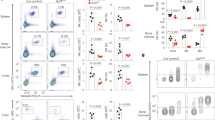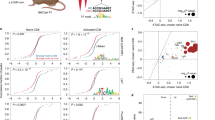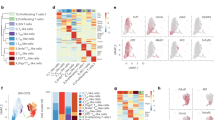Abstract
The human killer cell immunoglobulin-like receptor (KIR) genes contain multiple promoters that control the process of gene activation and variegated expression of KIR on natural killer (NK) and T cells. Specific subfamilies of KIR genes have differences in the timing and tissue specificity of expression: however, previous studies of the proximal KIR promoters have not shown significant differences in activity between differentially expressed KIR gene subsets. The recent identification of an intermediate KIR promoter (ProI) associated with KIR2DL1 expression suggested a central role for this element in KIR expression. The current study identifies ProI elements in all of the KIR genes, revealing four classes of ProI that correspond with four distinct expression phenotypes of KIR subgroups: KIR2DL2/S2/L3 that are expressed early in reconstituting NK after transplant; KIR2DL4 that is expressed by CD56-bright NK in a non-variegated manner; KIR3DL3 that is not expressed by circulating NK cells; and the remaining KIR that are expressed by subsets of CD56-dim NK. The four classes of ProI are structurally diverse and display distinct functional properties. Altogether, these results indicate that KIR ProI elements contribute to the tissue/cell-type specificity of KIR transcription and cooperate with the probabilistic proximal promoter to control KIR expression.
This is a preview of subscription content, access via your institution
Access options
Subscribe to this journal
Receive 6 digital issues and online access to articles
$119.00 per year
only $19.83 per issue
Buy this article
- Purchase on Springer Link
- Instant access to full article PDF
Prices may be subject to local taxes which are calculated during checkout






Similar content being viewed by others
References
Lanier LL . NK cell recognition. Annu Rev Immunol 2005; 23: 225–274.
Anderson SK, Ortaldo JR, McVicar DW . The ever-expanding Ly49 gene family: repertoire and signaling. Immunol Rev 2001; 181: 79–89.
Carrington M, Norman P . The KIR Gene Cluster. National Library of Medicine (US), NCBI: Bethesda, MD, USA, 2001.
Valiante NM, Uhrberg M, Shilling HG, Lienert-Weidenbach K, Arnett KL, D’Andrea A et al. Functionally and structurally distinct NK cell receptor repertoires in the peripheral blood of two human donors. Immunity 1997; 7: 739–751.
Held W, Kunz B . An allele-specific, stochastic gene expression process controls the expression of multiple Ly49 family genes and generates a diverse, MHC-specific NK cell receptor repertoire. Eur J Immunol 1998; 28: 2407–2416.
Kubota A, Kubota S, Lohwasser S, Mager DL, Takei F . Diversity of NK cell receptor repertoire in adult and neonatal mice. J Immunol 1999; 163: 212–216.
Yawata M, Yawata N, Draghi M, Partheniou F, Little AM, Parham P . MHC class I-specific inhibitory receptors and their ligands structure diverse human NK-cell repertoires toward a balance of missing self-response. Blood 2008; 112: 2369–2380.
Anderson SK . Probabilistic bidirectional promoter switches: noncoding RNA takes control. Mol Ther Nucleic Acids 2014; 3: e191.
Wright PW, Li H, Huehn A, O'Connor GM, Cooley S, Miller JS, Anderson SK . Characterization of a weakly expressed KIR2DL1 variant reveals a novel upstream promoter that controls KIR expression. Genes Immun 2014; 15: 440–448.
Stulberg MJ, Wright PW, Dang H, Hanson RJ, Miller JS, Anderson SK . Identification of distal KIR promoters and transcripts. Genes Immun 2007; 8: 124–130.
Valiante NM, Uhrberg M, Shilling HG, Lienert-Weidenbach K, Arnett KL, D'Andrea A et al. Functionally and structurally distinct NK cell receptor repertoires in the peripheral blood of two human donors. Immunity 1997; 7: 739–751.
Rajagopalan S, Long EO . A human histocompatibility leukocyte antigen (HLA)-G-specific receptor expressed on all natural killer cells. J Exp Med 1999; 189: 1093–1100.
Fischer JC, Ottinger H, Ferencik S, Sribar M, Punzel M, Beelen DW et al. Relevance of C1 and C2 epitopes for hemopoietic stem cell transplantation: role for sequential acquisition of HLA-C-specific inhibitory killer Ig-like receptor. J Immunol 2007; 178: 3918–3923.
Chan AT, Kollnberger SD, Wedderburn LR, Bowness P . Expansion and enhanced survival of natural killer cells expressing the killer immunoglobulin-like receptor KIR3DL2 in spondylarthritis. Arthritis Rheum 2005; 52: 3586–3895.
Trundley AE, Hiby SE, Chang C, Sharkey AM, Santourlidis S, Uhrberg M et al. Molecular characterization of KIR3DL3. Immunogenetics 2006; 57: 904–916.
Dunphy SE, Guinan KJ, Chorcora CN, Jayaraman J, Traherne JA, Trowsdale J et al. 2DL1, 2DL2 and 2DL3 all contribute to KIR phenotype variability on human NK cells. Genes Immun 2015; 16: 301–310.
Antinore MJ, Birrer MJ, Patel D, Nader L, McCance DJ . The human papillomavirus type 16 E7 gene product interacts with and trans-activates the AP1 family of transcription factors. EMBO J 1996; 15: 1950–1960.
Stewart CA, van Bergen J, Trowsdale J . Different and divergent regulation of the KIR2DL4 and KIR3DL1 promoters. J Immunol 2003; 170: 6073–6081.
van Bergen J, Stewart CA, van den Elsen PJ, Trowsdale J . Structural and functional differences between the promoters of independently expressed killer cell Ig-like receptors. Eur J Immunol 2005; 35: 2191–2199.
Miller JS, McCullar V . Human natural killer cells with polyclonal lectin and immunoglobulin-like receptors develop from single hematopoietic stem cells with preferential expression of NKG2A and KIR2DL2/L3/S2. Blood 2001; 98: 705–713.
Davies GE, Locke SM, Wright PW, Li H, Hanson RJ, Miller JS et al. Identification of bidirectional promoters in the human KIR genes. Genes Immun 2007; 8: 245–253.
Li H, Pascal V, Martin MP, Carrington M, Anderson SK . Genetic control of variegated KIR gene expression: polymorphisms of the bi-directional KIR3DL1 promoter are associated with distinct frequencies of gene expression. PLoS Genet 2008; 4: e1000254.
Cichocki F, Hanson RJ, Lenvik T, Pitt M, McCullar V, Li H et al. The transcription factor c-Myc enhances KIR gene transcription through direct binding to an upstream distal promoter element. Blood 2009; 113: 3245–3253.
Santourlidis S, Trompeter HI, Weinhold S, Eisermann B, Meyer KL, Wernet P et al. Crucial role of DNA methylation in determination of clonally distributed killer cell Ig-like receptor expression patterns in NK cells. J Immunol 2002; 169: 4253–4261.
Chan HW, Kurago ZB, Stewart CA, Wilson MJ, Martin MP, Mace BE et al. DNA methylation maintains allele-specific KIR gene expression in human natural killer cells. J Exp Med 2003; 197: 245–255.
Gomez-Lozano N, Trompeter HI, de Pablo R, Estefania E, Uhrberg M, Vilches C . Epigenetic silencing of potentially functional KIR2DL5 alleles: implications for the acquisition of KIR repertoires by NK cells. Eur J Immunol 2007; 37: 1954–1965.
Trompeter HI, Gomez-Lozano N, Santourlidis S, Eisermann B, Wernet P, Vilches C et al. Three structurally and functionally divergent kinds of promoters regulate expression of clonally distributed killer cell Ig-like receptors (KIR), of KIR2DL4, and of KIR3DL3. J Immunol 2005; 174: 4135–4143.
Acknowledgements
This project has been funded in whole or in part with federal funds from the National Cancer Institute (NCI), NIH, under contract HHSN261200800001E. This research was supported in part by the Intramural Research Program of the NIH, NCI, Center for Cancer Research. The content of this publication does not necessarily reflect the views or policies of the Department of Health and Human Services, nor does mention of trade names, commercial products or organizations imply endorsement by the US Government.
Author information
Authors and Affiliations
Corresponding author
Ethics declarations
Competing interests
The authors declare no conflict of interest.
Rights and permissions
About this article
Cite this article
Li, H., Wright, P., McCullen, M. et al. Characterization of KIR intermediate promoters reveals four promoter types associated with distinct expression patterns of KIR subtypes. Genes Immun 17, 66–74 (2016). https://doi.org/10.1038/gene.2015.56
Received:
Revised:
Accepted:
Published:
Issue Date:
DOI: https://doi.org/10.1038/gene.2015.56
This article is cited by
-
The KIR2DL1 intermediate upstream element participates in gene activation
Immunogenetics (2023)
-
Association of killer cell immunoglobulin-like receptors with endemic Burkitt lymphoma in Kenyan children
Scientific Reports (2021)
-
Genotype B of Killer Cell Immunoglobulin-Like Receptor is Related with Gastric Cancer Lesions
Scientific Reports (2018)



